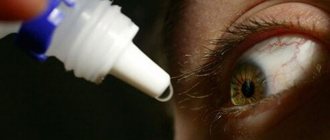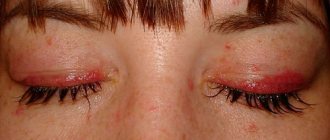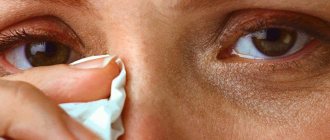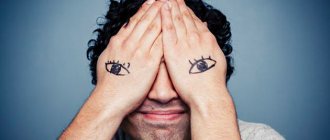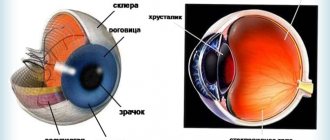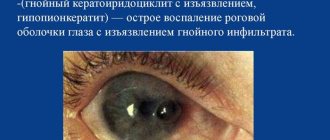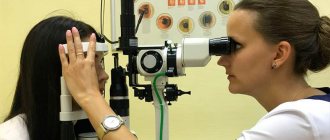A retinal burn is a severe damage to the visual system that can cause vision loss. This type of damage is associated with exposure to external factors. When the retina is burned, vision deteriorates significantly, so if characteristic symptoms are detected, you should immediately consult a doctor.
Retinal damage occurs due to:
- ultraviolet rays. The lesion does not cause loss of vision, but has a negative effect on the condition of the retina. More severe consequences occur when exposed to sunlight reflected on a layer of snow. In this case, the rays sharply enter the retinal area and can cause visual impairment. Damage also occurs if you do not protect your eyes during a solar eclipse;
- laser Laser burns can occur during laser coagulation and other procedures performed using laser devices. Damage occurs if the laser radiation is strictly directed. As a result, hemorrhage occurs, and if left untreated, visual function is partially or completely lost;
- chemical substances. The retina is affected when acids, alkalis, aerosols, paints, perfumes, medications, and alcohol-containing substances come into contact with the eyes;
- high temperatures. A retinal burn occurs due to hot liquid (water, oil) or steam getting into the eyes. Damage is also associated with exposure to molten metals and flames on the eyes;
- quartz lamp. Damage to the structures of the organs of vision can occur in a hospital or residential premises when quartzing is carried out with a special lamp.
There is also a combined burn, in which several factors act on the retina of the organ of vision. A classic example is a welding burn. In this case, the eye is exposed simultaneously to sparks and ultraviolet radiation generated during the operation of welding equipment.
An eye burn can be caused by instilling solutions into the eyes that are not intended for this purpose (drops for the ears or nose, alcohol tinctures). Damage can also occur during the process of eyelash extensions, due to poor-quality glue or incorrect procedure, or dyeing eyelashes with paint.
The risk of damage to the retina increases if a person, when in contact with harmful substances or devices that produce radiation, does not use personal protective equipment.
What to do if your eyes are burned with alcohol?
What to do if your eyes are burned with alcohol? This question is asked by people who have been exposed to a chemically active substance. Eye damage from alcohol can occur if the liquid is handled carelessly. A patient who is faced with such a problem should be given immediate medical attention and sent to a medical facility for further treatment as soon as possible.
Stages of damage and types
Based on what specific substance led to the malfunction of the eye apparatus, the pathology can be combined, chemical, thermal or radiation. An eye burn with alcohol is classified as a chemical disorder.
There are 4 degrees of severity, on which possible negative consequences and symptoms directly depend. Analyzing the affected area, the substance may be negatively affected by:
- periorbital area and skin on the eyelids;
- cornea in combination with the conjunctiva;
- the eyeball, in this case its destruction is observed;
- adnexal apparatus, etc.
In addition, patients should understand that, depending on the speed of pathological processes, there are 4 stages. When ammonia or medicinal alcohol comes into contact with the eyes, the pathology goes through the following stages:
- The initial stage lasts no more than 2 days. During this, tissue death occurs. Gradually, the cornea begins to swell and the patient feels discomfort.
- The duration of the second stage largely depends on the individual characteristics of the person. It can last for 2 days or several weeks. In addition to swelling of the corneal tissue, serious trophic disorders are formed. This process can cause irreparable harm to health.
- The third stage lasts for another 2-3 months. Due to the fact that oxygen is supplied to the tissues of the eye apparatus in insufficient quantities, hypoxia and trophic processes begin. During this, the vessels of the cornea begin to grow.
- The final stage lasts for several years. After you have burned yourself with vodka or alcohol and all the previous stages have already passed, the tissue begins to scar. For this process, the body produces collagen in large quantities.
First aid for an eye burn must be provided at the initial stage, otherwise the patient may face serious impairment or completely lose vision.
Even a specialist will find it difficult to determine how deep the burn was in the near future after the incident. To determine this factor, it is necessary to know the duration of exposure to the chemical and its strength. In the first few hours after exposure to ammonia or another type of alcohol, the symptoms will be pronounced, so it is problematic to assess the person’s condition.
Degree of damage
Depending on the severity of the burn, the following degrees of retinal damage are distinguished:
- first. Features: redness of the skin around the eyelids, swelling of the cornea, burning sensation in the eye. At this stage, only the superficial part of the organ of vision is damaged;
- second. The cornea becomes cloudy, and white areas—dead cells—form on the surface of the mucous membrane. Colored spots flash in front of the affected organs of vision. This degree is characterized by damage to the deep tissues of the eye;
- third. A dense gray-white film forms on the surface of the burned eye. The victim feels severe pain. The conjunctiva becomes dirty yellow, the cornea loses its transparency;
- the fourth, the most difficult. Necrosis of all tissues occurs, the cornea is damaged or completely destroyed. Vision deteriorates significantly. Injury to the vitreous body and lens occurs.
First degree injuries can be treated safely. More severe injuries entail consequences that affect the victim’s ability to fully see.
Manifestations of violation
Signs of a violation largely depend on how long the irritating factor has been in effect. Most often, patients complain about:
- acute pain that is present for a long time;
- swelling formation;
- redness of the mucous membrane and skin;
- swelling of the eye apparatus;
- profuse lacrimation;
- high sensitivity to natural and artificial light sources;
- the appearance of a white film on the eyes;
- decreased visual acuity;
- violation of intraocular pressure indicators, which manifests itself in corresponding discomfort.
The listed manifestations should not be taken as the only ones possible, since a person may complain of other symptoms. They appear against the background of concomitant diseases of the eye apparatus and other characteristics of the body. Also, if you burn yourself with alcohol, the pressure area may narrow.
A few days after the burn, all symptoms disappear, but this does not mean that the violation has passed without a trace. The pathology will progress regardless of whether there are external signs of a disorder or not. Conservative treatment in this case helps to avoid the development of serious complications and slow down the pathology. Unfortunately, it is not possible to improve visual acuity with medication alone; this will require surgical intervention.
Burn symptoms
The presence of a corneal burn can be detected not only by external manifestations, but also by a number of accompanying symptoms.
Among the most common are:
- Severe pain in the head;
- Unpleasant sensations in the eyes when exposed to light;
- Increased lacrimation;
- Decreased visual acuity;
- Narrowing viewing angles;
- Uncontrolled and involuntary contraction of the muscles of the eye and eyelids;
- Severe pain in the eye;
- A feeling that a foreign body has entered the eye, preventing the eyeball from moving normally.
Please note that symptoms do not always appear immediately after a burn. For example, if a person receives a corneal burn as a result of exposure to ultraviolet rays, then the first visible symptoms appear only 10 hours after the injury.
Emergency care and therapy
What to do if your eyes are burned with alcohol? Everyone needs to know the first aid recommendations, since in such a situation there is no time to find a solution. Before treatment begins, the patient should be treated on site. It involves the immediate removal of the irritating substance that comes into contact with the eyes. It must be removed despite the spasm and acute pain that occurs in the first few hours.
You should begin treating your eyes with copious amounts of rinsing. This can be done with water or a solution of potassium permanganate. Before arriving at a medical facility, it is allowed to use an anesthetic drug.
A patient with a burn must be admitted to an ophthalmology hospital. They continue to do jet rinsing, but use saline instead of water.
It is extremely dangerous to independently select any neutralizing agents for yourself, since it is unknown how such treatment will affect the condition of the eyes.
After the examination, the doctor will remove all foreign bodies from the conjunctival zone and prescribe eye ointment and drops. Such drugs have an anesthetic effect. In addition, treatment involves drip administration of atropine. In cases with serious violations, a course of antibiotics is prescribed. Also, to moisturize the mucous membrane, special drops are prescribed that replace natural tears.
Along with medications, eyelid massage and physiotherapy are prescribed. Surgical treatment is performed only in extreme cases when there is a risk of complete loss of vision. By contacting a specialist in a timely manner, severe consequences after a burn can be avoided.
source
Treatment
A first-degree corneal burn (primary necrosis) is treated according to the following scheme:
- A burn to the cornea of the eye caused by welding or other burning agents begins by rinsing the eye with bottled or boiled water. This procedure is necessary to remove remaining foreign body particles.
- In case of chemical burns, the eyes are thoroughly washed with water or neutralizing solutions under pH control (for acids - 2% solution of baking soda, for alkalis - 2% solution of boric acid). The procedure lasts about 20 minutes.
- An antiseptic ointment is placed in the conjunctival sac.
In case of a 2nd degree corneal burn, treatment is aimed at activating metabolic processes in tissues, replenishing the lack of vitamins and nutritional components, and improving blood circulation in the eyes.
In addition, therapeutic measures aimed at reducing the intensity of exposure to toxins on the body are required, as well as taking antioxidant, decongestant, anti-inflammatory drugs, and antihypertensive drugs (with increased intraocular pressure).
At the third stage, glucocorticosteroids are added to the main therapy. At stage 4, in the absence of complications, resorption therapy is performed.
Important! To completely remove the chemical reagent from the surface of the eye, the organ of vision is irrigated with detoxification agents, saline solution, ascorbic acid and B vitamins for 3-5 days in a row.
In case of severe swelling of the eyeball, Taufon, sodium chloride is used as a rinsing agent.
The following are prescribed as anti-inflammatory eye drops:
- Diclofenac;
- Naklof;
- Diklo-F.
NSAIDs can be prescribed for oral administration (to avoid general intoxication of the body), intramuscularly and rectally.
The following are used as antibacterial therapy:
- Levomycetin;
- Phloxal;
- Tobrex.
The drugs are injected into the conjunctival sac. Antibiotics of a number of penicillins are prescribed for internal administration; aminoglycosides and pephalosporins are used for intravenous and intramuscular administration.
To activate the restoration processes of the cornea, the following are prescribed: ointment, Dexpanthenol gel, Solcoseryl, Emoxipin drops (1%), Actovegin. Systemically, patients consume B vitamins and ascorbic acid.
Treatment at home
Treatment of a burn to the cornea of the eye is also carried out at home. The following are considered the most effective ways to combat corneal burns.
- Honey. Promotes rapid tissue regeneration, is rich in vitamins A, B, E, C, and has an antimicrobial effect. What to do for treatment? It is enough to take it daily in its pure form or add it to your favorite drinks.
- Potato compress . The grated potatoes are laid out on gauze folded in several layers. The compress is applied to injured eyes for 15 minutes twice a day.
Chamomile, calendula, linden flowers . One of the plants in the amount of one spoon is poured with boiling water (250 ml), infused for 20 minutes, then carefully filtered. A tampon soaked in warm liquid is applied to the damaged eye for 15-20 minutes.
- Cold compress . To relieve swelling, apply a compress for 2-3 minutes.
Traditional methods should be used along with medications and after consultation with a doctor.
First aid
The further spread of the burn process directly depends on the provision of first aid. Therefore, the first thing to do is to rinse the affected area with water, turn out the eyelids and remove particles of burning reagents.
Next, an antibacterial eye ointment is placed into the conjunctival sac. It is advisable to administer a serum with an antitetanus effect. After this, a bandage is applied, and the patient is immediately sent to the hospital.
A welding burn causes severe pain. Therefore, it is more advisable to take a painkiller or use ointments with an anesthetic effect (Hydrocortisone, Dexamethasone).
If the cornea is injured due to the ingress of acidic agents, then the eye area should be washed generously with soda solution, and alkalis with boric acid solution.
What is the danger of eye burns from alcohol-containing substances?
Contact of pure alcohol on the mucous membrane of the eye can cause serious consequences. The danger of its impact on the organs of vision is due to the fact that alkali absorbs intraocular moisture, dissolving the protein. As a result, the mucosal tissues die and ethanol begins to directly affect the lens and cornea, which leads to its clouding (this is most clearly visible in the photo), a sharp deterioration in vision and profuse lacrimation.
An eye burn with ethyl alcohol, which is always in your home medicine cabinet, is no less dangerous for the mucous membranes than a burn with medical alcohol. Another negative point is that with a high degree of burn injury, the patient cannot from the first minutes appreciate the seriousness of his situation due to dulling of painful sensations.
This occurs due to the fact that the components of alcohol affect the nerve nodes surrounding the damaged eye tissue. This is why getting a burn with an alcohol solution requires immediate qualified medical care, especially if the injury is diagnosed in a child. You shouldn’t wait for symptoms to appear; it’s better to seek help right away and don’t waste time!
How to provide emergency assistance for an eye burn with alcohol?
If the eye has been burned with ammonia, the first thing you need to do is wash the organ of vision for 20 minutes with clean water at room temperature or a weakly concentrated solution of potassium permanganate. Under no circumstances should you rub the affected eye!
If the pain syndrome is pronounced, and with an alcohol burn this often happens, you can take a painkiller (Nurofen, Ketorolac or Paracetamol). After first aid has been provided, the patient should lie down, relax and wait for the ambulance to arrive.
What medications are used to treat burn injuries to the eye with an alcohol solution?
After emergency assistance is provided, the victim is taken to the hospital. There he is washed with saline solutions, after which the ophthalmologist draws up a scheme for further therapy. As a rule, treatment of eye burns with alcohol is carried out using medications in the form of drops and ointments. I bring to your attention a standard treatment regimen for burn injury with an alcohol solution:
- To prevent infection from getting into the eye, antiseptic drops are installed 3-4 times a day, and ointments that contain an antibiotic are also applied.
- To stimulate regeneration of the cornea, drops of Taufon (4%) or Balarpan (0.01%) are instilled about 4 times a day. In parallel with this, Solcoseryl or Octovegin ointment (20%) is used twice a day.
- One of the consequences of an eye burn with alcohol can be iridocyclitis. To prevent this, intramuscular injections of Atropine (1%) and Diclofenac are administered.
- If IOP is increased, the damaged organ of vision is instilled with Timolol drops (0.25-0.5%).
- In order to prevent scarring of the affected mucous membrane of the eye, the victim may be prescribed to wear special contact lenses.
Burn degrees
Taking into account the severity of the injury, there are 4 degrees of chemical eye burns. Each of them has its own characteristics:
| Degrees of chemical eye burns | Signs, chances of maintaining vision |
| Light | Hyperemia of the conjunctiva and eyelids develops. There are erosions of the cornea and swelling of the epithelium. The patient can count on complete restoration of the affected organ of vision. |
| Average | In addition to hyperemia, clouding of the cornea and the appearance of small bubbles are observed. At this stage, there is still hope for recovery. |
| Heavy | Most of the eyeball is affected. There are necrotic changes in the conjunctiva and skin of the eyelids. The cornea loses its transparency. Iridocyclitis or cataracts often develop, and a scab covers the conjunctiva. |
| Particularly heavy | All eye tissues are damaged. Carbonization of the sclera and deep necrosis are detected. The victim is diagnosed with perforation and total opacification of the cornea, damage to the lens, vitreous body, secondary glaucoma, and uveitis. The outcome is most often unfavorable. |
In addition to the eyeballs, the chemical can affect the skin and cause the appearance of a large number of small blisters on the surface of the epidermis.
Is traditional medicine effective in the fight against alcohol burns to the eyes?
When carrying out treatment at home, it would not be superfluous to resort to traditional medicine recipes, thanks to which it will be possible to speed up the healing process and restore damaged tissues of the organ of vision.
Speaking about effective folk remedies recommended for use in cases of eye burns with alcohol-containing solutions, we should immediately highlight a decoction of chamomile or calendula, which is used to wash inflamed eyelids and mucous membranes. Sea buckthorn oil, which has anti-inflammatory, wound-healing and analgesic properties, has proven itself to be excellent in combating the consequences of alcohol burns to the eyes.
It is imperative to consume as many vitamins as possible, which will help improve vision and restore eye tissue. It is recommended to pay special attention to the following products:
- Carrot;
- Fish fat;
- Blueberry.
To enhance the therapeutic effect, in parallel with drug therapy and folk recipes, it is useful to massage the eyelids.
At the 2nd stage of eye healing, you can resort to physiotherapeutic treatment methods, but you must first consult with an eye doctor.
At what stages of a burn can drops be used?
Doctors prescribe medications even in the most severe cases. They perform the functions of disinfection and tissue regeneration, including in cases of serious damage to the mucous membrane. However, there is no point in using drops for retinal burns at the very last, fourth, stage. In this case, the damage is so extensive that complex treatment is required.
The effectiveness of the drugs has been proven for stages 1 and 2 injuries. In these cases, they cope with the task. At stage 3, serious therapy is required and the victim cannot cope with the use of drops alone.
Medicines intended for instillation show good results for 1st and 2nd degree burns of the organs of vision. In the presence of more serious damage, their use is practically meaningless. Stages 3 and 4 will require an integrated approach. The course of medications must be chosen by the attending physician.
conclusions
Friends, let me remind you once again that an eye burn with an alcohol solution is a fairly serious injury, the treatment of which should under no circumstances be delayed. Otherwise, you risk losing your vision completely or partially!
If suddenly you or your loved ones become victims of a burn, immediately seek ophthalmological help; do not try to figure out how to treat this kind of damage on your own. An experienced specialist will assess the severity of the injury and, based on this, select a competent treatment and rehabilitation regimen.
Don’t forget to leave comments and questions, and if you have experienced a similar situation, share your experience, this is very important. Take care of your eyes and be healthy! Best regards, Olga Morozova!
How can you get burned by alcohol?
Alcohol is an active chemical substance that is used both for domestic purposes and in medicine. And quite often, if handled carelessly, injuries occur.
Most often, burns from alcohol are observed on the skin. Such a lesion can occur in people with fairly delicate and sensitive skin. You can get them when treating wounds or during cauterization of acne.
Alcohol tinctures are used to treat various diseases. If such concentrated drugs enter the larynx or esophagus, they cause damage to internal tissues. Lubricating or rinsing with saturated alcohol products for a sore throat can lead to burns of the mucous membrane.
Injuries to the tissues of internal organs also occur at home due to the consumption of high concentrations of alcohol by mistake. In any case, the degree of damage largely depends on the time of exposure to the chemical and its percentage in the solution.
Alcohol burn: symptoms
Alcohol burns can be both internal and external. Injuries to different organs have their own specific symptoms.
| Affected organs | Main symptoms |
| Skin covering | Redness of the skin tissues is observed, blisters filled with liquid form. Gradually, the top layer of skin darkens. A hard crust forms at the site of the affected area. |
| Esophagus | Sharp pain in the stomach appears, breathing becomes difficult and it becomes difficult to swallow. Weakness and dizziness appear. Burns to the esophagus often lead to loss of consciousness. |
| Organs of vision | The cornea of the eyes turns sharply red, a strong burning sensation is felt, during which profuse tearing occurs. This causes vision loss, which can be temporary or permanent. Blisters and swelling may also appear on the mucous membrane. |
External injuries caused by alcohol are characterized as first-degree burns. They do not pose a significant danger to the general health of the victim. Treatment of skin injuries occurs quite quickly. When first aid is carried out correctly, only pink spots remain on the skin, which disappear without a trace over time.
Injuries to internal organs pose a great danger to human health. Such alcohol burns are often accompanied by severe symptoms and require immediate hospitalization.
Damage to the mucous membranes of the eyes by alcohol, treatment and the further condition of the victim depends on the speed of first aid. Severe burns to the organs of vision can lead to blindness.
Classification and causes of damage to the organ of vision
Most often, a chemical or thermal burn of the eye mucosa occurs, less often radiation, each of them has its own provoking factors and characteristics of the course.
Chemical
The causes of eye burns are the contact of alkalis and acids in the area of the organ.
Toxic alkalis include:
- Caustic soda;
- Caustic potassium;
- Ammonia;
- Ethyl;
- Lime.
Among the dangerous acids are:
- Sulfur;
- Wine;
- Vinegar;
- Salt.
Injury can be caused by construction varnishes, paints, and other industrial substances entering the organ area. A burn on the eyelid can occur after exposure to poisons from toxic plants, such as hogweed.
In many cases, self-medication, improper prescription of eye drops, and potent medications cause additional damage.
The composition of the damaging substance is of no small importance, for example, liquid - when it enters the organ of vision, it mixes with tears. Thanks to this, they come out of the cavity faster and cause less damage.
Ray
Injury occurs when the area of the visual organ is exposed to ultraviolet light or welding equipment for a long time. This type of damage is called electroophthalmia. Similar lesions can also occur in tourists and climbers when the light flux is reflected from the snow; in medical workers, radiation burns of the eyelid and eyes from a quartz lamp occur.
Depending on the intensity and time of exposure, there are varying degrees, ranging from slight redness and lacrimation to loss of vision.
Thermal
A thermal burn of the eye occurs when it is exposed to high temperatures, boiling steam, or hot objects for a long time. Therefore, it is important to eliminate the irritant in a timely manner and treat a thermal burn of the eye.
The cause of the injury may be incendiary or flammable mixtures of fireworks and firecrackers.
When exposed to sunlight and high temperatures, damage to the cornea and eyelids occurs. It is believed that this is the mildest injury to the visual organs, after which it recovers quite quickly, without serious consequences.
According to the degree of damage, thermal burns of the eye are divided into the following types:
- “1” - the eyelids turn red, a swelling forms under the eye, erosion of the cornea;
- “2” - clouding of the cornea is observed, white fragments appear on the mucous membrane, cells die, blisters form on the eyelids;
- “3” - severe damage to the deep layers, the conjunctiva becomes brown, the cornea loses transparency;
- “4” is the most dangerous injury with tissue necrosis, the cornea is completely destroyed, the lens is affected.
Thermal injuries and burns to the eyes have the following symptoms:
- lacrimation;
- Severe sharp pain;
- Discoloration of the cornea;
- Impaired visual acuity;
- Edema.
For more serious injuries and burns to the eyes, the following phenomena are added to the main symptoms:
- Glaucoma;
- Scarring;
- Cataract.
First aid
Proper first aid for chemical burns significantly affects the effectiveness of further treatment.
For external damage
Alcohol can cause damage to the skin, but such injuries are very minor. They do not require emergency medical attention.
In case of external damage, rinse the damaged area with water for 10 minutes.
If the skin is damaged, the substance causing the burn must be completely removed. To do this, use clean water, which is used to wash the injured area for ten minutes. After this, the burn site is treated with pain-relieving and anti-inflammatory drugs.
In rare cases, a burn may be accompanied by death of the upper layers of the skin. Only an ambulance team can help in such a situation.
Alcohol burn: internal
If a particularly strong concentration of alcohol solution gets into the digestive tract, medical help is required. Before their arrival, you must quickly carry out the following actions:
- cause a gag reflex;
- Give the victim plenty of liquid at room temperature to drink.
In case of internal injuries, before the doctors arrive, it is necessary to induce a gag reflex.
If the oral cavity is affected, then a long rinse with a soda solution is required. For severe pain due to burns of internal organs with alcohol, a painkiller should be used.
Burn of the mucous membrane of the eyes
Injuries to the organs of vision with an alcohol solution require rapid elimination of the substance affecting the mucous membrane. The eye is washed with plenty of clean water. Alcohol removal is carried out within twenty minutes. You can also use a weak solution of potassium permanganate for washing.
After removing the aggressive substance, anti-burn ointments, which also have analgesic properties, are applied to the damaged areas. If your eyes are damaged by alcohol, you should definitely consult a doctor.
Symptoms
A mild degree is characterized by:
- pain in the eye;
- redness and slight swelling of tissues;
- sensation of a foreign body in the eye;
- blurred image;
- blurred vision;
- with chemical burns, a sharp closure of the eyelids is observed (which is why most often the burn can only spread to the eyelids or eyelashes);
- photophobia;
- profuse lacrimation;
- blepharospasm.
Severe burn processes are accompanied by the following symptoms:
- conjunctival necrosis;
- exposure of the sclera;
- formation of ulcers;
- scarring;
- corneal clouding;
- fusion of the eyeball and the skin of the eyelid;
- neurotrophic keratitis.
Important! Severe burns can lead to decreased vision and complete loss of vision.
Therapeutic measures
Treatment of chemical burns is carried out using various healing, soothing, anti-inflammatory and pain-relieving drugs. Therapeutic actions depend on the extent and location of the lesion.
For skin burns
Damage to the skin with alcohol when treated with anti-burn ointments goes away within a couple of days. For minor injuries, tissue can recover without special treatment.
Treatment of skin burns with alcohol is aimed at eliminating symptoms. The affected area is treated with special preparations three times a day. The following ointments will cope well with pain and help relieve redness on the skin:
- Levomekol;
- Bepanten;
- Panthenol;
- Solcoseryl.
For skin burns with alcohol, Levomekol is used.
After the healing process is completed, agents are sometimes used that prevent the formation of scars and eliminate age spots. Treatment of skin burns is mainly carried out at home.
For burns of the larynx and esophagus
Damage to the tissues of the digestive organ by alcohol requires more complex treatment. Therefore, all therapeutic actions are carried out only in a hospital setting.
The treatment process for a burn of the esophagus consists of the following stages:
- complete gastric lavage;
- conducting gastroscopic examination of internal organs;
- administration of anti-shock drugs – “Prednisolone”;
- the use of sedatives and anti-spasm drugs - Atropine and Relanium.
Antibacterial treatment is also carried out for preventive purposes, which helps to avoid complications. The patient is prescribed drip nutrition. Food intake is carried out gradually during the healing process of the tissues of the internal organs. In the first days, it is allowed to consume foods in liquid form.
For burns to the mucous membrane of the eyes
If alcohol gets into your eyes, the most important thing is to quickly rinse and treat the mucous membrane. Prolonged exposure to a concentrated alcohol solution on the organs of vision can lead to complex injuries and cause loss of vision.
To treat burns of the mucous membrane of the eyes, the following drugs are used:
- antiseptic drops or ointments;
- pain-relieving drugs;
- antibacterial agents;
- restoring and healing drops or ointments - “Taufon” or “Actovegin”.
Taufon is often used to treat burns of the eye mucosa with alcohol.
Treatment of eye injuries is carried out only under the supervision of a doctor. Therapeutic methods depend on the severity of damage to the eye mucosa and the individual characteristics of the patient’s body. Upon completion of the treatment process, it is recommended to wear special lenses.
Traditional methods for eliminating burns with alcohol
Redness on the skin from burns with alcohol can be quickly eliminated with the help of traditional medicine. The following remedies help with burns:
- Grate the onion on a fine grater. Blot a piece of gauze in the resulting mass and apply it to the affected area. This remedy helps prevent the appearance of blisters.
- Raw grated potatoes relieve redness and pain. It should be applied to damaged skin several times a day.
- Aloe juice promotes tissue restoration process. You can also use the leaves of the plant. They are cut and applied to the wound with the venerable side.
- Peppermint solution eliminates irritation. Mint is infused in hot water. The cooled liquid is applied in the form of lotions to the injured skin.
- Calendula decoction. This remedy is applied three times a day to burns. With the help of calendula decoction, the skin is quickly restored.
Calendula decoction is one of the folk methods for treating alcohol burns.
It is also good to use grated carrots or honey to heal burns. To relieve symptoms, burns are brushed with beaten egg.
You cannot independently treat burns of the esophagus or eye mucosa using traditional methods. Such injuries require drug therapy, and alternative medicine can be used during the recovery period and only with the permission of the attending physician.
Alcohol burn: possible complications
On the skin from a burn with alcohol, the healing field leaves virtually no traces. Skin restoration after such an injury occurs quickly. Complications can only arise in special cases:
- the victim’s wounds do not heal well due to diabetes mellitus or a weakened immune system;
- infection in the burn area;
- A large area of skin is affected.
If after receiving an alcohol burn to the skin within three days there is no change for the better, then you should consult a doctor for help.
More complex injuries with alcohol, such as burns of the esophagus or the mucous membrane of the organs of vision, require long-term therapy. After treatment of gastric burns, long-term dietary nutrition is often prescribed. If the eyes are damaged by alcohol, loss of visual function is possible, which can be restored during treatment. Complex burns to the visual organs can lead to blindness.
Timely first aid for alcohol burns will help to avoid complications during subsequent treatment. It should be remembered that self-medication of injuries with chemical substances of internal organs or the mucous membrane of the eyes can lead to irreparable consequences and cause disability.
Alcohol got into the eye - Therapy
anonymous (Female, 28 years old)
Getting furacelin alcohol into the eye
Hello. I have a question. Today I instilled furacelin sleep into the child’s ears (we treat inflammation). The child was small, twitched and accidentally got 2 drops into his eye. Wash with boiled water. The eye is not...
anonymous (Male, 25 years old)
Tsindol supsendia got into the eyes
Good evening. A 2-year-old child has chickenpox. Apply cindol suspension. Last night there was redness in the corner of my eye. Today half of my eye is red. I called the ophthalmologist. They advised Oftalmoferon antiviral drops, 1 drop...
anonymous (Female, 28 years old)
Alcohol tincture got into the child's eye
A 1.5 year old child got tonsilgon (19% alcohol) in his eye. The eye was washed. Within 2 hours there was no redness, no swelling, no tearing. The eye doesn't rub. Now the child is sleeping. Whether…
Valera Ischenko (Male, 43 years old)
Tampons in the nose blocked the ear
in short, some kind of chronic infection (sinusitis, ethmoiditis?). blue under the eyes, mucus rolls down the nasopharynx, no temperature, the puncture was done 7 years ago, 2 times. They pumped out the old pus, there was a smell from the nose (stood out...
anonymous (Female, 22 years old)
Alcohol got into the child's eyes
Hello! An 11-month-old child got 95% medical alcohol in his eyes. Washed with water. Now the child’s eye is slightly swollen, reddish and watery.. Please tell me what to do? Will this be a problem for...
Anastasia Bezotvetnaya (Female, 23 years old)
Chronic blepharoconjunctivitis
Hello! My name is Nastya, I am 23 years old. A little over a year ago, a problem with my eyes appeared. On the lower and then on the upper edge of the eyelid (mucous membrane, not the skin where eyelashes grow,...
Preventing burns with alcohol
Chemical burns can occur both at home and in the workplace. To avoid an accident, the following safety precautions should be observed:
- do not use industrial alcohol to prepare tinctures;
- store the concentrated active substance out of the reach of children;
- Do not use alcohol-based products if you have hypersensitive skin.
Careful handling of chemicals and their proper storage will help maintain health not only for yourself, but also for the people around you.
Alcohol burns are classified as first and second degree injuries. Therefore, lesions do not pose a particular danger. Treatment of such chemical injuries consists of eliminating pain and repairing damaged tissue. The success of therapeutic measures depends on the speed and accuracy of first aid to the victim.
source
